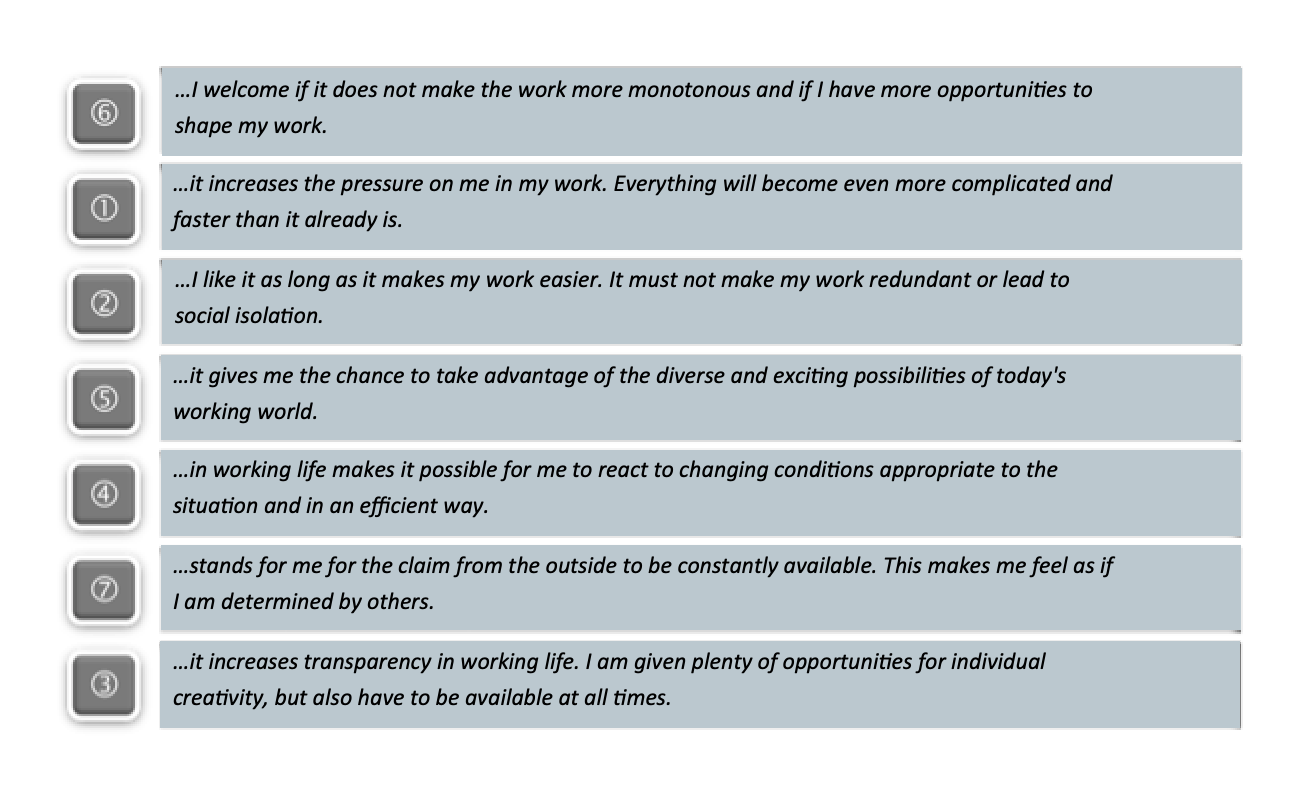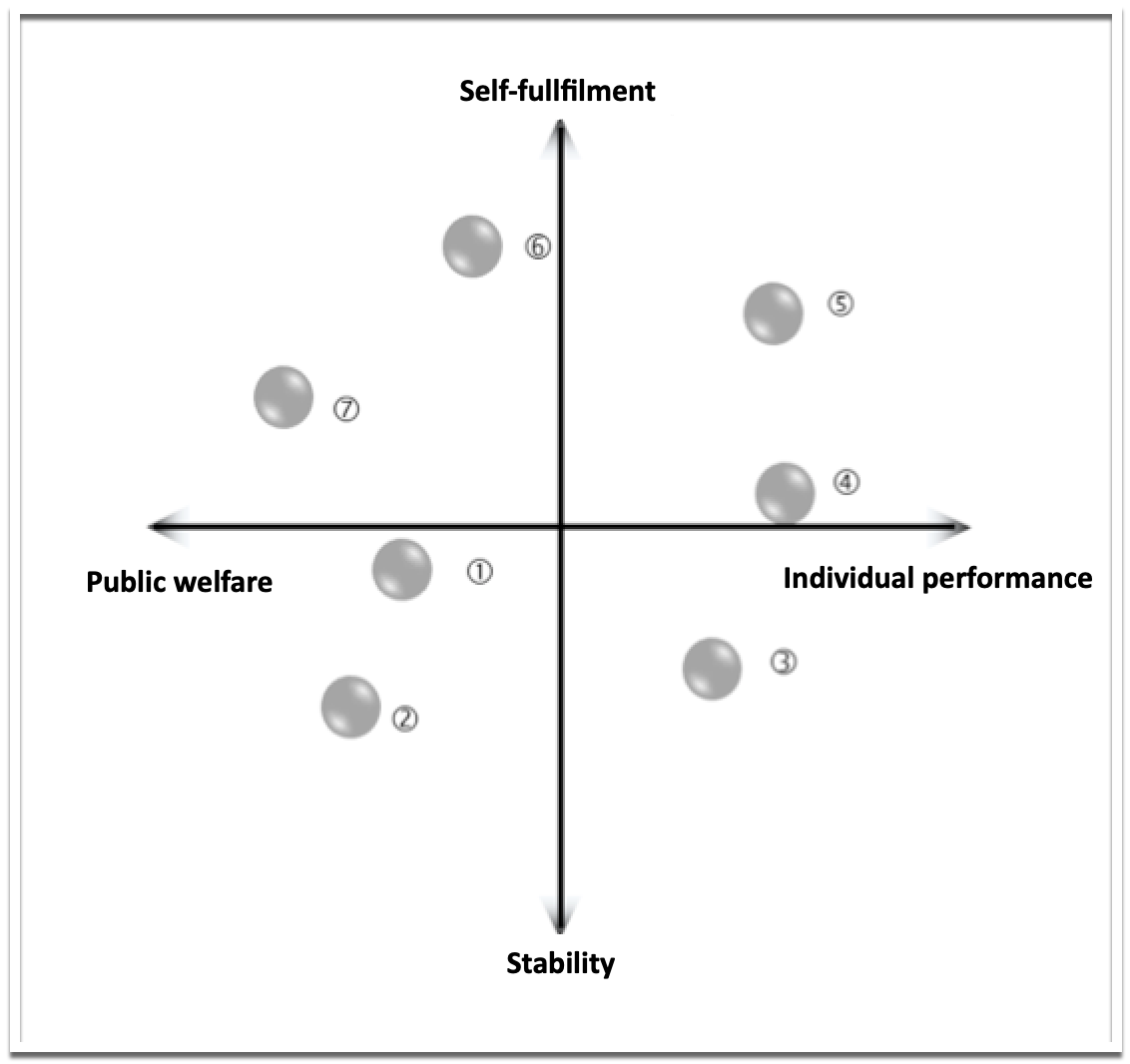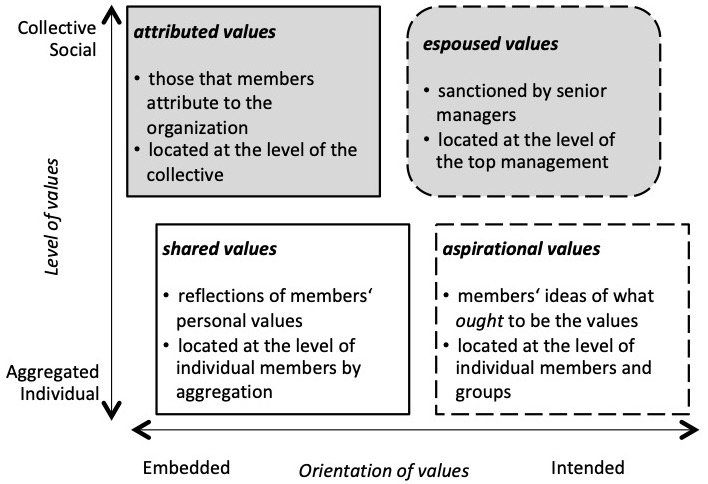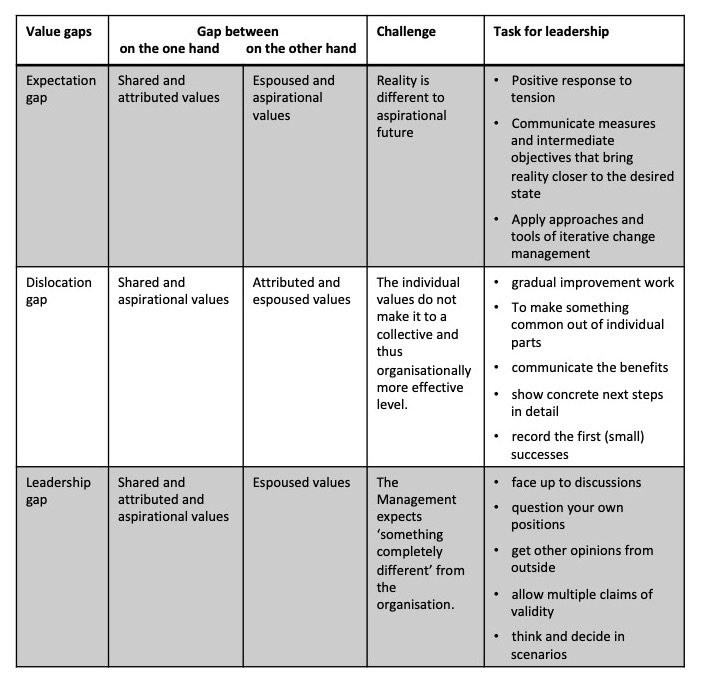Part 3 of 3:
The third part deals with the management level and the question why it is almost necessary to lead out of the paradox of values.
A short review: While the first part was about individual values and their diversity, the second part dealt with the dynamics of value gaps at the organisational level. According to this, organisational values are not a defined set of values that is fixed and established. Rather, they are a reflection foil for the decision-making practice of each organisation member. And also fuel for the development of the organisation.
Four value fields
Let us take the values of a company I know well: innovative – willing to perform – loyal – cooperative. I have changed the terms only slightly. Not so that you can start the search engine you trust … customer protection, I’m sure you understand that].
The second blog already dealt with the contradiction of values. There, I saw this as a possibility for reflection on my own actions: Which of the (contradictory) values should gain the upper hand in the current situation and why? This could be a question for reflection that helps to guide oneself in this situation. At management level, it is not only about these possibilities. It is about more. For the sake of the organisation, it is important and right, even necessary, for management to propagate contradictory values. Harmony leads to inattention and uniformity at this point. Organisations cannot afford both – especially not in dynamic situations.
Back to the four exemplary values mentioned above:
- innovative – is a task-related and above all externally (‘new on the market’) value;
- willing to perform – also refers to the task, but is directed inwards into the organisation;
- loyal – has an ethical reference and is inward-looking;
- in partnership – is also ethical and at the same time outward-looking (customers, suppliers, authorities).
You see: The values move on four different playing fields, so in practice they can quickly come into conflict with each other: Am I loyal to my rather sluggish colleague or willing to perform? In negotiations, am I loyal to my back office (limit of the negotiation mandate) or to the client (stability of the client relationship)?
Wouldn’t it be better if the organisation were to adopt values that are less likely to conflict? After all, values are supposed to provide orientation, aren’t they? Two questions, two times the same answer: No.
Let me start with the second question. So the one about orientation through values: In the second part of this blog I had already pointed out that values do not provide orientation. Not like a fixed star that gives a clear and correct answer to a decision. Rather, values are an offer for reflection in decision-making situations.
What is the use of a paradox of values?
Lotte Lüscher and Marianne Lewis gave the reasons for the ‘no’ to the first question about the harmonious values. The two found that goals and values at management level are characterised by contradictions. This has nothing to do with the fact that people at this organisational level are less capable of logic or enjoy doing the inappropriate. Rather, the management level is permanently faced with the challenge of integrating new figures, data and facts that do not fit into the previous picture (the ‘story’ or the ‘big picture’). After a short time, this no longer looks like a clearly laid out map of Mannheim city centre, but more like a festival site after four days. So far it may sound as if it all originates from a defensive position.
Much more important for the paradoxical patchwork of values, however, is that it enables management to address the various demands in the organisation much better: For example, the sales department attaches more importance to partnership, the development department to innovation, the operative department is committed to performance and ‘loya’ is the topic of controlling. The art and task of management is now not to leave it at the ‘value-based’ approach to each department, but to
- understand and accept each value logic for itself as management
- make understand the logic of each value, where there are contradictions to other (equally valuable) values;
- explain any value logic, which may confuse others;
- show the implications of any value logic if it were practised alone and ‘100% pure’;
- experiment with all value logics and act as a sparring partner.
This requires being open to experiment, to catch up with other aspects, to acknowledge and endure contradictions. And to represent all this actively and communicatively. This leads to professional action in generalised uncertainty.
Keeping the organisation alive
It requires a form of dialogue that could be well described as ‘palaver’ if the term did not have such a bad reputation. In African culture, palaver is highly regarded. It is about getting to know each other and getting to know each other, it is a social activity, it is about community building. And that is what the management of paradoxical values is all about: negotiating, letting go of overly rigid values and demands, and creating a common ‘workable certainty’. Only the paradoxes of values make it possible to lead an organisation in a living way.
Values as a productive challenge
Finally a look at three parts “Values”. As long as not
- values described as binding limit the diversity that employees bring to the company anyway (see part 1);
- the resulting value gaps are filled in by ‘announcements from above’ (see part 2)
- management takes sides in negotiating between the conflicting values of individual departments, groups or individuals (Part 3)
As long as values are understood in the plural, as long as values are negotiated fairly and as long as management maintains the value paradoxes – as long as values are a productive challenge for organisation and leadership.
The formulation of organisational values is the beginning of this challenge, not the end result.
Lüscher, L.S., Lewis, M.W. (2008): Organizational Change and Managerial Sensemaking: Working Through Paradox. In: Academy of Management Journal. (51), S. 221 – 240.
Part 2 of 3:
Values are multiple. There is a ‘colourful disorder’, which is the task of leadership to manage and use. This is – very roughly summarised – the content of the first blog about values from July. It was about the personal level of values. This second part is about the organisational level and thus about organisational values.
“In X steps to unique core values”
In this way or similar, the aim is to use brainstorming, prioritised lists and participatory workshops to find those organisational values that are exceptional. Two claims are hidden in such promises:
- not only the services and products should be unique, but also the values – I am not aware of any reason for this;
- despite the thousands and thousands of existing organisational values there are still undiscovered and unused ones.
On the other hand, a look at the real existing organisational values shows a great homogeneity of what organisations are worth – what they regard as desirable, good, right: integrity, attentive, team-oriented, willing to perform, open-minded, trusting, efficient, innovative, loyal, responsible, courageous, cooperative, tolerant, exemplary, integer, creative, determined, sincere. Take a handful of these or similar terms, explain them briefly and you have already described the landscape of values of more than four out of five organisations. Why should organisational values be unique? This only increases the likelihood of values occupying an exclusive niche – and getting by the large number of customers and employees. This is precisely why most people play it safe and use the standard values in their hawker’s trays: in this way they prove that they are ‘connectable’ (another such value). By the way, this connectivity becomes a special challenge when values are to apply globally. Intercultural distortions are likely to emerge quickly. Read more in this project report.
The content is important, but practice is even more important
If everyone is doing something similar, is it still worth investing energy, time and money in developing organisational values? The clear answer is: Yes! However, the result – the often polished concept of values and the definition that has been discussed many times – is less important than three other points:
- The process of developing organisational values is more important. Because this is where it becomes clear whether and how the propagated values are practised. If ‘team-oriented’ and ‘innovative’ is important to you, you should design the process of developing organisational values in the same way.
- The process of deciding on the basis of and based on values is more important. If the values alone provide characteristics that can be used to distinguish ‘good’ from ‘better’, then they should be applied (more on this in the third part of the blog).
- The process of constantly referring to the values is more important. Often the values are printed on mousepads and mugs and published on the website, but otherwise do not play a role. Then even the last employee notices that the work here is hypocritical – outwardly hooey, inwardly yuck. In the best case, an organisation has no values, but does them in daily practice and communicates them in the same way.
You see: The practice of the values is decisive whether and how they are anchored in the organisation with its stakeholders. It is not the culture that shapes the values, it is the practice of the values that creates the culture.
Vague values as echo wall
Vague values are not a shortcoming. Values are always vague. There is no clear definition of ‘freedom, equality and fraternity’, not even among the protagonists of the French Revolution. Even if you write detailed glossaries or definitions of terms: In a concrete situation, a concrete person will decide how to interpret and apply the personal and organisational values here and now, based on his or her individual concrete values and the concrete organisational values. This is how values get meaning: through and in practice.
The possibilities for adjusting values in situations not only increase the acceptance of organisational values among the workforce, they also allow contradictory values to be dealt with. According to the Russian-British historian of ideas, Isaiah Berlin, values are not compatible with each other, they often contradict each other. How, for example, should an employee who discovers fraud in his department behave – loyally or responsibly … or tolerantly? How good, if this employee can weigh up the three values and reveals at least one of them.
Organisational values therefore do not provide any orientation. Although this is often claimed. They are merely points of reference that allow reflection in the practice of a concrete situation. They do not guide. They give every member of the organisation the opportunity to guide themselves on the basis of the ‘echo from the wall of values’.
Four forms of organisational values
The first blog was about personal values and the colourful bouquet of values with which each employee comes into the organisation. To stay with the image: The result is a huge, colourful flower meadow, which is now the focus of attention at the organisational level. Humphrey Bourne and Mark Jenkins have brought structure to this flower meadow of values. They distinguish four forms of organisational values:
- Aspirational values
Members assume that they should be organisational values, i.e. that they are desirable and trend-setting. - Shared values
The common values that arise when employees in an organisation are socialised through their daily interaction with each other. The organisational character is thus reflected in the personal values of its members. - Espoused values
Those values that are endorsed by managers from their positions. Documented in formal statements, the values are often assumed by management to be organisational values. - Attributed values
They are very generally attributed to the organisation by its members. The values are, for example, fed back to internal persons (company founders) or external attributions (company image).
The contents of the four forms do not usually coincide, in many cases they even contradict each other.
Three value gaps as a task for leadership
These non-overlaps result in so-called value gaps at organisational level. The following three are the typical ones in practice, from which different challenges and tasks for leadership arise.
Effective organisational values are therefore not those values that are advertised on the front page of the organisation: “Look how great we are”. That is image building. Organisational values are the result of the daily handling of the three value gaps that arise time and again. From them the dynamics of organisations arise.
Only worry about your organisation when these value gaps no longer exist – because then it is dead.
Frank Wippermann
Part 1 of 3:
Values offer orientation – too many values confuse and create arbitrariness. Today you will learn how to play the keyboard of values.
Then values are no longer the subject of a soft skill culture for nice speeches and colourful graphics on the website. Instead, values will become a strategic issue, creating clarity and understanding, especially in times of uncertainty. This first of three parts is about ‘values in the plural’. And about expectations of the digital transformation and the individual values associated with it.
A ‘valuable’ example to start with
It is important to Hannah Meier to be able to work self-determined and as independently as possible. This enables her to discover and work on many new things. Tim Schreier prefers to carry out routine tasks in clear and delimited areas. This gives him the peace and quiet to concentrate on one thing at a time. The two seem to have very different working motives, perhaps due to personal type preferences. But do they also have different values? Values, understood as those qualities of a decision or a thing that a person considers desirable, good, right? That could be: Curiosity and autonomy in Hannah, determination and perseverance in Tim. Or how about professionalism and quality awareness in both?
Let’s agree on one thing: they have both different and corresponding values. The question then arises as to what values the organisation for which both work has. And whether these values are in any way binding, guiding or orienting. And whether violations of values result in sanctions – then it’s not far to the Guardian Council …
Values are transformable and negotiable
Systems with values with which a claim to truth is made are by definition ideologies. I assume that in a pluralistic society no one strives for this. Values are therefore changeable and negotiable. In the past months of Corona this could be well observed:
- Protection of life and health’ is the top priority – this was the principle on which the lockdown was based in mid-March.
- “If there is an absolute value in our constitution at all, then it is the dignity of man. That is inviolable. But it does not exclude the possibility that we must die.” Wolfgang Schäuble, President of the Bundestag [26th April 2020 in the magazine Tagesspiegel. Please note the condition “if there is an… at all, then …”]
- There are other things that are (at least) as important as health: [here, please use what is most important to you right now].
- And there are people who protest furiously against a ‘dictatorship’ that they cannot even come close to describing, let alone prove
What is the point of transformable and negotiable values?
Valuable leadership gives orientation
“Modern societies do not need ultimate moral justifications or ultimate moral unity. What they need are regulative fictions with which they can constantly come to a new understanding of what is wanted and desired. Values are just such regulative fictions: They dynamize, emotionalize us humans; they neutralize and pluralize our narrow view of what is and of what should be.” (NZZ, 14th March 2016)
And for all those who now shout “arbitrariness – disorder – value relativism”. Yes, values are:
- relative – after all, we do not live in absolutism.
- messy – like the dynamic and complex world in which they are discussed.
- arbitrary – depending on what a person likes about desirable things.
This is good news for managers, by the way. Because if there were values that were fixed and firmly established, an orienting leadership would be superfluous. There would only be a controlling function. But that is not leadership, that is monitoring.
I highly recommend the German book by Andreas Urs Sommer, whom I quoted above. You can order it online from companies with loopholes in their tax practices, or in your local bookstore or as an e-book. It all depends on the values that are important to you right now: convenience, local economy, conservation of resources. These three values alone will show you that they are hard to reconcile. You can read more about them in the third part of our blog.
Self test: Seven individual expectations and values
The diversity of individual expectations can be well illustrated using the example of digital transformation. The following table shows seven statements on digital transformation. Select the statements that you think best apply to you.

As a result, you should now have one to three statements that you think are appropriate. This selection says a lot about you and your attitude not only to the digital transformation, but to gainful employment in general. And your selection gives an indication of the values that are now important to you in your work.
If you can make out the numbers of these statements in the following diagram, then you have positioned yourself – somewhere between two or three of the seven points in the diagram.

Values below expectations
This also determines which two of the four values on the axes are more important to you. You use these two values as a guide. They are your inner compass for decisions about ‘good, desirable, right’. By the way, it is quite possible that you have a different value preference in your working life than in your private life. If so, you may have to switch on the journey to and from work. This is possible – for many people the living room ego differs from the professional ego. It only becomes exciting in two cases:
- your value preference is different from what is propagated and demanded in your organization
- your value preference differs from the constellation of values you deal with during your work
I will come to the first point in the continuation of this blog in the second part, the second in the following section.
„Value-Dynamite“ and Value-Dynamics
Only very rarely do colleagues agree on the values in their work. And agreement would not be good at all (more on this below). Most of the time there is an abundance of values – in different constellations:
- They are in the minority in the group of equal colleagues. Then you will find it difficult to assert yourself in discussions and, above all, in decisions. Think about the benefit your favoured decision can have in the world of values and argumentation of the majority. And then highlight these benefits.
- Your value preferences are different from the rather homogeneous world of values of your employees. Then you will have difficulties in finding understanding for your decisions. Enthusiasm is certainly not to be expected, rather excitement. Here you have two options: Either you create ‘quick wins’ for the skeptics in the sense of an iterative change management. Or you rule by instruction. The first takes a long time, the second is not very stable. Decide – on the basis of your values. A coaching or sparring session can bring a lot of clarity.
- All value preferences are represented in your area of responsibility. Out of fourteen people in your organizational unit, there are probably exactly two for each of the seven statements on digital transformation who think it is good. You should not now interpret this negatively as a ‘chicken pile’ (or, for all from Bavaria: as a rag rug). On the contrary: Congratulations to this team. It has been proven that diversity increases profitability by a fifth to a third. McKinsey was not the only one to find this out in a study. The International Labour Organization (ILO) also points this out. With this colourful ‘disorder of values’, you have the chance that different perspectives will influence decisions. This means that these decisions, even if they take a lot of effort to make, have two firm foundations: The leg of the weighed arguments and the leg of the cross-value binding.
Using diversity for leadership
You see: Values as “relative fictions” change and are very helpful in their diversity. This makes leadership necessary that neither sets nor decides on nor proclaims values – but includes them, brings them together and lets them apply. Values only exist in the plural.
This is the first part of a three-part blog series on the topic of “Valuable Management”. The second part (in September) deals with three value gaps within an organization, the third part (at the end of the year) is about value conflicts at management level. In both blogs, the dynamics that make these gaps or conflicts possible are discussed.
picture: pixabay





